In this lesson, we’ll discuss an interesting concept related to straight lines – family of lines.
Consider the following lines:
L1: 2x + 3y – 8 = 0
L2: x – y + 1 = 0
These lines intersect at the point (1, 2). Take a look.

Now, let’s add the equations L1 and L2. Why? I’ll tell you in a bit.
We’ll get:
(2x + 3y – 8) + (x – y + 1) = 0
⇒ 3x + 2y – 7 = 0
What we got is an equation of a different line. But there’s something special about this line – it passes through (1, 2) too.

A coincidence? Maybe.
Let’s take another line, obtained by adding L1 and twice of L2. That is:
(2x + 3y – 8) + 2(x – y + 1) = 0
⇒ 4x + y – 6 = 0
Another different line. But wait, this line passes through the point (1, 2) as well.

Hmm. Doesn’t look lie a coincidence now. Or does it?
One more example. I’ll take three times the first equation and subtract the second from it. We get:
3(2x + 3y – 8) – (x – y + 1) = 0
⇒ 5x + 10y – 25 = 0
The resulting line again passes through the point (1, 2).

What’s going on?
Let’s focus on how we formed each of these new equations – we multiplied L1 and L2 by some non-zero constants, and added (or subtracted) the resulting two equations.
That is, each of the equations is of the form:
a(L1) + b(L2) = 0 or a(2x + 3y – 8) + b(x – y + 1) = 0
Now, what happens if we substitute the coordinates (1, 2) in the above equation?
Since (1, 2) is the point of intersection of the lines, it lies on both the lines. And therefore, substituting (1, 2) will make the both the terms 2x + 3y – 8 and x – y + 1 equal to zero.
This means that the expression a(2x + 3y – 8) + b(x – y + 1) will also become zero – the values of a and b do not matter!
Let me show you that anyways. On substituting (1, 2), we’ll get:
a[2(1) + 3(2) – 8] + b[1 – 2 + 1]
= a(2 + 6 – 8) + b(1 – 2 + 1)
= a(0) + b(0)
= 0
As I said, the values of a and b didn’t matter. The expression will always be zero if we substitute (1, 2).
In other words, the point (1, 2) will always lie on the line a(2x + 3y – 8) + b(x – y + 1) = 0, i.e., for any values of a and b.
If we keep changing the values of a and b, we’ll get different lines (as we saw above). And, all of these lines will pass through point (1, 2), which is the point of intersection of the two lines.
That is, the equation a(2x + 3y – 8) + b(x – y + 1) = 0 represents a family of lines, all ‘members’ of which pass through the point of intersection of 2x + 3y – 8 = 0 and x – y + 1 = 0.
We can also write the above equation as:
(2x + 3y – 8) + (b/a)(x – y + 1) = 0 (assuming a ≠ 0)
⇒ (2x + 3y – 8) + λ(x – y + 1) = 0
Here, different values of λ will give different lines, each of which pass through (1, 2).
Here’s a simulation where you can play around with the parameters a and b, and observe the resulting lines.
Does the line a(2x + 3y – 8) + b(x – y + 1) = 0 always pass through the points of intersection of 2x + 3y – 8 = 0 and x – y + 1 = 0?
Lesson Summary
- L1 + λL2 = 0, where λ is a parameter, represents a family of lines, all of which pass through the point of intersection of L1 = 0 and L2 = 0.
- Any line passing through the point of intersection of L1 = 0 and L2 = 0, will have its equation of the form L1 + λL2 = 0, where λ is a parameter.